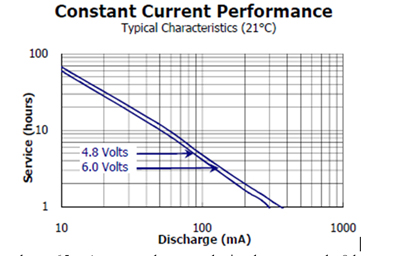8-Hour Power Calculation
There were five batteries on the COACH: two 7.2 V NiCd batteries and three 9 V Energizer batteries. The draw on each battery is compared with its capacity in this section, to show that the COACH would be able to operate for at least 8 hours between charges.
9 V Energizer Battery: E128
According to the E128’s datasheet, the current draw with all features operational is 65 mA. The following capacity chart comes from Energizer’s datasheet for their 9 V battery (yes, there really is a datasheet for that):
Thus, we can see that a 65 mA current draw results in almost exactly 8 hours of battery life. Phew!
9 V Energizer Battery: Mutiny Lamp
The mutiny lamp was measured to have a resistance of 26 Ω. With only the resistance of the MOSFET in series, the current draw of the lamp when on would be about 300 mA. However, the mutiny lamp would not be on all or even most of the time. Since the worst-case scenario would be constantly receiving and suppressing mutinies, in which the lamp would be on about 25% of the time, we can estimate that the lamp would be on overall about 20% of the time. Thus we have approximately a 60 mA draw from the battery at all times, very close to what the E128 draws. Thus, again, we would expect this lamp to last almost exactly the required 8 hours of time.
9 V Energizer Battery: Music Player
The resistance across the music player was about 100 kΩ, so when playing the system drew 0.09 mA. Already we can see that this will not even get close to the 8-hour limitation, though we also must consider that the player was only on for 20 seconds out of every 3 minutes or so, for a percentage use of about 10%. Thus, if the music player were the limiting factor in the battery life of the COACH, it would last for several thousands of hours!
7.2 V NiCd Battery: Seven-Segment Displays
One 7.2 V NiCd battery was used to exclusively power the seven-segment displays, since they required greater than the regulated 5 V and were likely to be a significant source of current draw. The seven-segment displays were both on during Paired operations as well as I Am Available operations, but both off during other Not Paired times. Since over an eight hour period TOWRPs would almost certainly have batteries die and be removed from play for recharging, we can therefore estimate that the seven-segment displays would be on about 75% of the time. However, not all segments were on all the time; for a simple approximation, we can say that half of the segments were lit at any one time. With a 7.2 V battery after the protection diode drop of 0.6 V, the current draw across the 220 Ω current-limiting resistors would be 30 mA. Thus, four segments per display and two displays total results in 240 mA. That amount drawn 75% of the time from a 1500 mAh battery results in 8.33 hours of life. Again, a close shave!
7.2 V NiCd Battery: All other circuitry
There are two many calculations for the remaining circuitry to describe individually, but here is a table summarizing the calculations and the resulting life of the fifth and final battery.
Component |
Worse Case |
Resistance |
Current |
Percent |
Relative |
Xbee LED On |
1.5 |
1600 |
0.00094 |
100 |
0.0009 |
Xbee LED |
1.5 |
1600 |
0.00094 |
100 |
0.0009 |
Xbee Transmit |
3.3 |
N/A |
0.04500 |
50 |
0.0225 |
Xbee Receive |
3.3 |
N/A |
0.05000 |
50 |
0.0250 |
Team Indicator |
3.2 |
100 |
0.03200 |
100 |
0.0320 |
Not Paired LED |
3.2 |
47 |
0.06809 |
25 |
0.0170 |
Throttle Opamp |
0.45 |
1000 |
0.00045 |
100 |
0.0005 |
Free Analog |
0.45 |
1000 |
0.00045 |
100 |
0.0005 |
Encoder (A - avg. |
2.5 |
22000 |
0.00011 |
100 |
0.0001 |
Encoder (B - avg. |
2.5 |
22000 |
0.00011 |
100 |
0.0001 |
Jettison the |
5 |
1000 |
0.00500 |
99 |
0.0050 |
Total |
0.1045 |
Thus, for the 7.2 V battery with a 1500 mAh life, the lifetime of operation is 14.36 hours.


